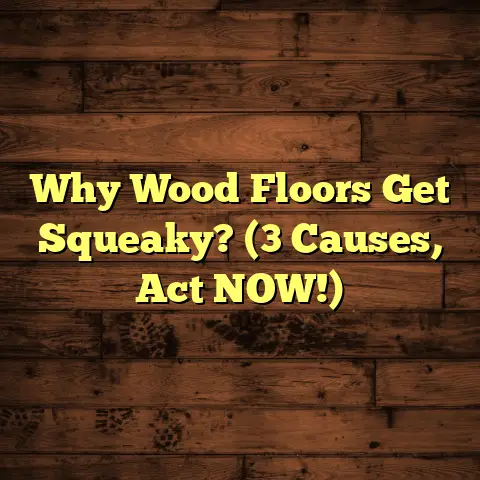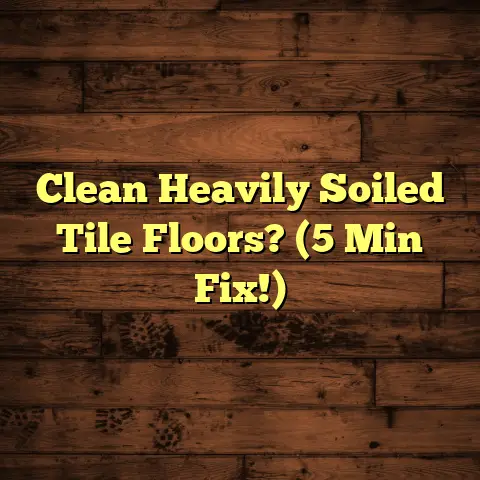Choose Non-Slip Flooring (3 Slip Scores Can Save Lives!)
Hey everyone! As a flooring contractor, I’ve seen firsthand the devastating consequences of slips and falls. It’s not just about a bruised ego; it’s about real injuries, potential lawsuits, and a compromised sense of security.
That’s why I’m super passionate about non-slip flooring. It’s not just a trend; it’s a necessity, especially in homes with kids, seniors, or anyone with mobility issues. And guess what? Choosing the right flooring is easier than you think, thanks to something called “slip scores.”
Let’s dive in and explore how these scores can help you make informed decisions and potentially save lives!
Understanding Slip Scores
What exactly are slip scores? They’re basically ratings that tell you how slippery a flooring material is. Think of it like a safety grade for your floors.
Various testing methods are used to determine these scores, like the ASTM and ANSI standards. These tests simulate real-world conditions to give you an accurate picture of how the flooring will perform.
I’m going to break down three key slip scores that you need to know:
Dynamic Coefficient of Friction (DCOF)
DCOF measures how much friction there is when something is already in motion.
Think about it: when you’re walking and your foot is sliding forward as you take a step, that’s dynamic friction in action. DCOF is especially important in wet conditions, like bathrooms or kitchens.
A higher DCOF means more friction, which translates to less slippage.
As a general rule, look for a DCOF of 0.42 or higher for level surfaces expected to be wet. This is based on ANSI A137.1 standards. https://tile.org/
Static Coefficient of Friction (SCOF)
SCOF measures the force required to start something moving.
This is relevant in dry settings, where you’re standing still and then begin to walk. A higher SCOF means you’re less likely to slip when you first put your foot down.
While DCOF is the more modern and reliable measurement, SCOF is still sometimes used.
Generally, a SCOF of 0.5 or higher is considered safe for dry, level surfaces.
Pendulum Test Results
The pendulum test simulates a heel strike, mimicking the way we naturally walk.
A pendulum with a rubber slider swings across the flooring surface, and the resulting “British Pendulum Number” (BPN) or “Slip Resistance Value” (SRV) indicates the slip risk.
This test is particularly good at replicating real-world slip and fall scenarios.
Here’s a general guideline:
- High Slip Risk: Below 24 BPN
- Moderate Slip Risk: 25-35 BPN
- Low Slip Risk: 36+ BPN
How to Interpret These Scores
Okay, so you know what the scores are, but how do you use them?
It’s simple: the higher the score, the less slippery the flooring. But it’s also important to consider the context.
A floor with a DCOF of 0.5 might be great for a dry living room, but it might not be enough for a commercial kitchen where spills are common.
I always tell my clients to think about the specific needs of their space and choose flooring with slip scores that meet or exceed those requirements.
Why Non-Slip Flooring is Essential
I’ve seen the aftermath of slips and falls, and trust me, it’s not pretty.
The consequences can range from minor bruises and sprains to serious fractures, head injuries, and even death. According to the CDC, one in five falls causes a serious injury. https://www.cdc.gov/falls/index.html
Beyond the physical toll, there are also legal and economic costs to consider.
Businesses can face lawsuits if a customer slips and falls on their property. And even in a home setting, a fall can lead to expensive medical bills and lost income.
Environments Where Non-Slip Flooring is Critical
Let’s talk about specific areas where non-slip flooring is a must:
- Bathrooms: With water and slippery surfaces like tile, bathrooms are a prime location for falls.
- Kitchens: Spills are inevitable in the kitchen, making non-slip flooring a smart choice.
- Hospitals and Healthcare Facilities: Patients, especially those with mobility issues, are at high risk of falls.
- Commercial Spaces: Restaurants, grocery stores, and other businesses with high foot traffic need to prioritize slip resistance.
Case Studies and Testimonials
I worked on a project for a local nursing home a few years back. They had a history of patient falls, and the administration was looking for a solution.
We installed non-slip vinyl flooring in the resident rooms and common areas. Within a few months, they saw a significant decrease in falls and a noticeable improvement in patient safety.
It was incredibly rewarding to see the positive impact our work had on the residents’ lives.
I’ve also had homeowners tell me that installing non-slip flooring in their bathrooms gave them peace of mind, knowing their elderly parents were safer.
These stories are what drive me to advocate for non-slip flooring.
Types of Non-Slip Flooring Options
Alright, let’s get into the nitty-gritty of different non-slip flooring materials:
Vinyl
Vinyl is a fantastic option because it’s durable, affordable, and comes in a wide variety of styles.
Look for textured vinyl options, as these provide extra grip. The slip ratings will vary depending on the specific product, so be sure to check the manufacturer’s specifications.
Tile
Tile can be slippery, but you can mitigate this by choosing the right type. Smaller tiles with more grout lines offer better traction. Also, look for tiles with a matte or textured finish.
Avoid polished or glossy tiles, as these tend to be the slipperiest.
Carpet
While not typically thought of as a “non-slip” flooring, carpet can actually provide excellent grip.
Carpet tiles are a great option, especially in commercial settings, because they’re easy to replace if damaged.
Wood
Solid wood can be slippery, especially when wet. However, you can find treated or textured wood options that offer better slip resistance.
Engineered wood with a textured surface is also a good choice.
Rubber
Rubber flooring is a top choice for commercial and industrial spaces. It’s naturally slip-resistant, durable, and comfortable underfoot.
It’s often used in gyms, hospitals, and other high-traffic areas.
Comparison of Materials
| Material | Aesthetic | Cost | Maintenance | Safety (Slip Resistance) |
|---|---|---|---|---|
| Vinyl | Wide variety of styles | Affordable | Easy to clean | Good (especially textured) |
| Tile | Classic, elegant | Varies | Can be challenging (grout) | Moderate (choose textured) |
| Carpet | Warm, comfortable | Varies | Requires regular vacuuming | Good |
| Wood | Natural, beautiful | Expensive | Requires special care | Moderate (choose textured) |
| Rubber | Industrial, modern | Moderate to expensive | Easy to clean | Excellent |
Choosing the Right Non-Slip Flooring
Okay, so how do you choose the right non-slip flooring for your space? Here are some factors to consider:
Foot Traffic Levels:
High-traffic areas like hallways and entryways need more durable and slip-resistant flooring than low-traffic areas like bedrooms.
Moisture Exposure and Cleaning Requirements:
Bathrooms, kitchens, and entryways are prone to moisture, so choose flooring that can withstand spills and frequent cleaning.
Aesthetics vs. Safety:
It’s important to strike a balance between aesthetics and safety. You want flooring that looks good and keeps you safe. Fortunately, there are plenty of stylish non-slip options available.
Consulting Professionals
When in doubt, consult with a flooring professional.
We can assess your specific needs, recommend the best flooring options, and ensure proper installation.
Installation and Maintenance of Non-Slip Flooring
Proper installation is crucial for ensuring the slip resistance of your flooring.
Follow the manufacturer’s instructions carefully, and don’t cut corners. If you’re not comfortable with DIY, hire a professional installer.
Maintenance Practices
Regular cleaning is essential for maintaining the slip-resistant properties of your flooring.
Use cleaning products that are specifically designed for your flooring type, and avoid using harsh chemicals that can damage the surface.
Common Mistakes to Avoid
- Using the wrong cleaning products: This can make your flooring slippery.
- Neglecting spills: Clean up spills immediately to prevent accidents.
- Failing to maintain grout lines: Dirty or damaged grout can reduce traction.
Future Trends in Non-Slip Flooring
The world of non-slip flooring is constantly evolving.
We’re seeing new technologies and innovations that are designed to enhance safety and sustainability.
Emerging Technologies
One exciting trend is the development of self-cleaning flooring. These materials use nanotechnology to repel dirt and water, making them incredibly easy to maintain.
Sustainability
Eco-friendly non-slip flooring options are also becoming more popular. Look for materials made from recycled content or renewable resources.
Industry Shifts
Consumer preferences are shifting towards safer and more sustainable flooring options. This is driving manufacturers to develop innovative products that meet these demands.
Case Studies and Real-World Applications
Let’s take a look at some real-world examples of successful non-slip flooring implementations:
- Restaurant Kitchen: A restaurant replaced its slippery tile flooring with non-slip rubber flooring. This significantly reduced employee injuries and improved overall safety.
- Hospital Bathroom: A hospital installed non-slip vinyl flooring in its bathrooms, which led to a decrease in patient falls.
- Residential Home: A homeowner installed non-slip wood flooring in their entryway, creating a safer and more welcoming space for guests.
These examples demonstrate the effectiveness of non-slip flooring in a variety of settings.
Conclusion
I hope this article has shed some light on the importance of non-slip flooring and the role of slip scores in making informed decisions.
Remember, choosing the right flooring can save lives, prevent injuries, and provide peace of mind.
I encourage you to evaluate your current flooring and take proactive steps to enhance safety in your home or business. Don’t wait for an accident to happen; prioritize flooring safety today!





